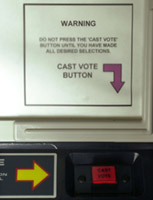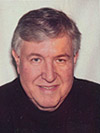| Home | Blog | Ask This | Showcase | Commentary | Comments | About Us | Contributors | Contact Us |

Some good reporting now could bring integrity to voting and help make it more tamper-proofASK THIS | November 315, 2004Follow the lead of Keith Olbermann and The New York Times editorial page. Go over this year's vote count, and consider making election systems a beat to help bring about reform for next time. By Barry Sussman Q. Was there tampering in the Ohio vote? In Florida's? Q. Were there three-hour lines in your state? Why? Keith Olbermann, who does the Countdown program on MSNBC, has a way of taking things seriously and spoofing them at the same time, so the election returns in Ohio and Florida were perfect stories for him, both on air and in his blog. Officials in Youngstown, he noted in a blog item on Nov. 10, "managed to catch a slight glitch in their voting there: a total drawn from all the precincts that initially showed negative 25,000,000 votes cast." Also, as he mentioned, in 29 precincts in Cuyahoga County, Ohio, there were 93,000 more votes than voters, according to the county's Web site. (The county later explained that some precincts' votes were counted several times.) In another blog item on Nov. 9, Olbermann noted that his reporting of an odd pattern in Florida resulted in protests from some e-mailers: There [Florida], 52 counties tallied their votes using paper ballots that were then optically scanned by machines produced by Diebold, Sequoia, or Election Systems and Software. 29 of those Florida counties had large Democratic majorities among registered voters (as high a ratio as Liberty County — Bristol, Florida and environs — where it’s 88 percent Democrats, 8 percent Republicans) but produced landslides for President Bush. On Countdown, we cited the five biggest surprises (Liberty ended Bush: 1,927; Kerry: 1,070), but did not mention the other 24. …Protesting e-mailers pointed out that four of the five counties we mentioned also went for Bush in 2000, and were in Florida’s panhandle or near the Georgia border. Many of them have long "Dixiecrat" histories and the swing to Bush, while remarkably large, isn’t of itself suggestive of voting fraud. That the other 24 counties were scattered across the state, and that they had nothing in common except the optical scanning method, I didn’t mention. My bad. I used the most eye-popping numbers, and should have used a better regional mix instead. That's Olbermann's treatment. Was there fraud in any of these places? We don't know. Some independent observers looked at Florida and Ohio and said they didn't see any. Regardless, suspicions will continue and probably grow louder because many harbor such bitter feelings and also because of the possibility that had there been fraud, it might not be detected. NY Times editorials: 'Making votes count' The New York Times editorial page examined vote problems throughout the election campaign and afterward. It did major original reporting and less spoofing than Olbermann, of course. Under the title "Making Votes Count," The Times has run 25 editorials since June 11, 2004, citing problems with the system and administrators. Some conclusions: Tampering is possible and could go uncaught; partisan hacks are often in charge; there are no uniform national standards and often no uniform state standards. Minority votes are sometimes suppressed; the law calls for automatic recounts in close elections but there may be no paper trail to make recounts valid; some chief defenders of electronic voting are state or local election officials with financial ties to the voting machine companies. There is a new area of contention — provisional ballots. And all of these are details, not nearly as weighty as the electoral college system, which cries out for change but is deemed sacrosanct. In normal times there are glitches in voting. But the situation we are now in is both dangerous and absurd. It needs to be reported everywhere. These shouldn't be one-day stories and they shouldn't be series left to fill a few pages and disappear. They should be regular beats. Good models are Olbermann, for how to make stories lively, and The Times's editorial page, for ideas. After the Supreme Court picked a winner in the 2000 presidential election the press quickly went on to other news and hardly looked back. This year, with so many faults exposed in the election system, reporters and editors once again have a choice: to get to work now or do nothing except save this year's clips and run them again in 2006.
|




